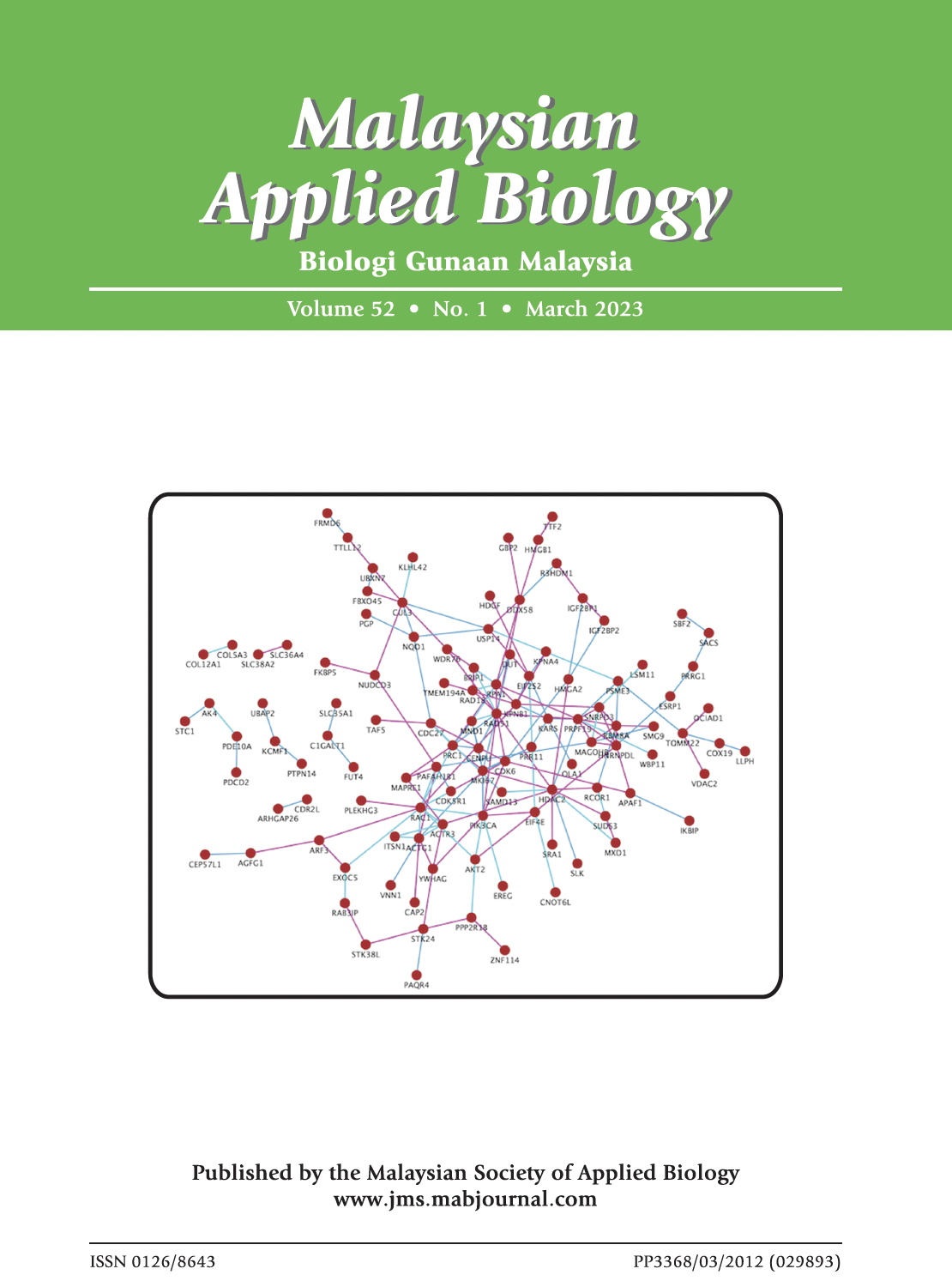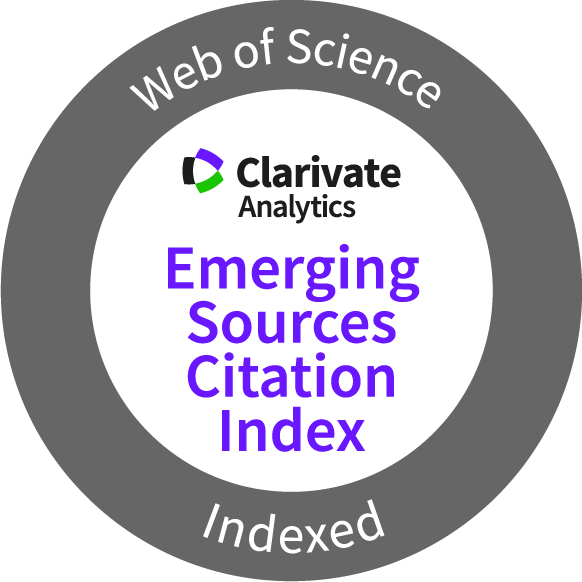The Effects of 2,4-Dichlorophenoxyacetic Acid on The Induction of Callus from Cotyledon and Hypocotyl Explants of Butterfly Pea (Clitoria ternatea)
Keywords:
2,4-Dichlorophenoxyacetic acid, callus induction, Clitoria ternatea, cotyledon, hypocotylAbstract
Clitoria ternatea (Butterfly pea) is a tropical medicinal and fodder legume from the Fabaceae family possessing various beneficial phytochemical compounds linked to the mammalian neuroprotective mechanism. Callus and cell suspension cultures are excellent alternatives for harnessing secondary metabolites from medicinal plants. The current study aims to induce callus from cotyledon and hypocotyl explants of C. ternatea for the establishment of cell suspension cultures. Cotyledon and hypocotyl explants from two-weeks-old seedlings were subjected to half-strength MS medium supplemented with 2,4-dichlorophenoxyacetic acid (2,4-D) at different concentrations (0.5 mg/L to 2.5 mg/L) and callus scoring and morphology were assessed at week 8 of culture. Results revealed that the treatment of 0.5 mg/L 2,4-D resulted in the highest percentage of callus induction (100%) and the highest callus scoring for both cotyledon and hypocotyl explants with friable callus morphology. Cotyledon explants exhibited a higher callus scoring with a relative value of 3.03 ± 0.20 compared to hypocotyl explants at 1.80 ± 0.12. This study thereby provides a basis for future studies on callus induction studies and the establishment of cell suspension cultures of C. ternatea for the production of valuable secondary metabolites linked to the memory enhancing properties of the plant.
Downloads
Metrics
References
Al-Asmari, A.K., Abbasmanthiri, R., Osman, N.M.A. & Al-Asmari, B.A. 2020. Endangered Saudi Arabian plants having ethnobotanical evidence as antidotes for scorpion envenoming. Clinical Phytoscience, 6(1): 1-13. DOI: https://doi.org/10.1186/s40816-020-00196-7
Al-Snafi, A.E. 2016. Pharmacological importance of Clitoria ternatea - a review. International Organization of Scientific Research Journal of Pharmacy, 6(3): 68-83.
Bernabé-Antonio, A., Maldonado-Magaña, A., Ramírez-López, C.B., Salcedo-Pérez, E., Meza-Contreras, J.C., González-García, Y., Toral, F.L.D., & Cruz-Sosa, F. 2017. Establishment of callus and cell suspension cultures of Eysenhardtia polystachya (Ortega) and fungistatic activity of their extracts. South African Journal of Botany, 112: 40-47. DOI: https://doi.org/10.1016/j.sajb.2017.05.023
Bhatia, S., Sharma, K., Dahiya, R. & Bera, T. 2015. Modern applications of plant biotechnology in pharmaceutical sciences. Academic Press. United Kingdom. DOI: https://doi.org/10.1016/B978-0-12-802221-4.00012-1
Byeon, Y., Choi, G.H., Lee, H.Y. & Back, K. 2015. Melatonin biosynthesis requires N-acetylserotonin methyltransferase activity of caffeic acid Omethyltransferase in rice. Journal of Experimental Botany, 66(21): 6917-6925. DOI: https://doi.org/10.1093/jxb/erv396
Castro, A.H.F., da Silva Tavares, H., Pereira, S.R.F., Granjeiro, P.A., da Silva, J.A. & Galdino, A.S. 2018. Production and characterization of lectin from Bauhinia holophylla (Fabaceae: Cercideae) calli. Plant Cell, Tissue and Organ Culture (PCTOC), 134(3): 423-432. DOI: https://doi.org/10.1007/s11240-018-1432-7
Cenkci, S., Kargioglu, M., Dayan, S., & Konuk, M. 2008. In vitro propagation of an endangered plant species, Thermopsis turcica (Fabaceae). Biologia, 63(5): 652-657. DOI: https://doi.org/10.2478/s11756-008-0125-9
Chan, L.K., Nallammai, S., & Boey, P.L. 2010. Production of artemisinin from cell suspension culture of Artemisia annua L. Asia Pacific Journal of Molecular Biology and Biotechnology, 18(1): 139-141.
Chan, Y.L., Bong, F.J, Subramaniam, S. & Chew, B.L. 2017. The effects of indole-3-butyric acid and 1-naphthaleneacetic acid on the induction of roots from Clitoria ternatea L. Journal of Sustainability Science and Management, 12(2): 63-70.
Chauhan, N., Rajvaidhya, S. & Dubey, B.K. 2012. Pharmacognostical, phytochemical and pharmacological review on Clitoria ternatea for antiasthmatic activity. International Journal of Pharmaceutical Sciences and Research, 3(2): 398.
de Arcaute, C.R., Soloneski, S. & Larramendy, M.L. 2016. Toxic and genotoxic effects of the 2,4-dichlorophenoxyacetic acid (2,4-D)-based herbicide on the Neotropical fish Cnesterodon decemmaculatus. Ecotoxicology and Environmental Safety, 128: 222-229. DOI: https://doi.org/10.1016/j.ecoenv.2016.02.027
Devi, B.P., Boominathan, R. & Mandal, S.C. 2003. Anti-inflammatory, analgesic and antipyretic properties of Clitoria ternatea root. Fitoterapia, 74(4): 345-349. DOI: https://doi.org/10.1016/S0367-326X(03)00057-1
Efferth, T. (2019). Biotechnology applications of plant callus cultures. Engineering, 5(1): 50-59. DOI: https://doi.org/10.1016/j.eng.2018.11.006
Frank, M., Rupp, H.M., Prinsen, E., Motyka, V., Van Onckelen, H. & Schmülling, T. 2000. Hormone autotrophic growth and differentiation identifies mutant lines of Arabidopsis with altered cytokinin and auxin content or signaling. Plant Physiology, 122(3): 721-730. DOI: https://doi.org/10.1104/pp.122.3.721
George, E.F., Hall, M.A. & De Klerk, G.J. 2008. Plant propagation by tissue culture. 3rd Edition. Springer, Dordrecht, The Netherlands. pp. 175.
Gomez, S.M., & Kalamani, A. 2003. Butterfly pea (Clitoria ternatea): a nutritive multipurpose forage legume for the tropics – an overview. Pakistan Journal of Nutrition, 2(6): 374-379. DOI: https://doi.org/10.3923/pjn.2003.374.379
Grossmann, K. 2003. Mediation of herbicide effects by hormone interactions. Journal of Plant Growth Regulation, 22(1): 109-122. DOI: https://doi.org/10.1007/s00344-003-0020-0
Ikeuchi, M., Sugimoto, K. & Iwase, A. 2013. Plant callus: mechanisms of induction and repression. The Plant Cell, 25(9): 3159-3173. DOI: https://doi.org/10.1105/tpc.113.116053
Ionkova, I. 2009. Optimization of flavonoid production in cell cultures of Astragalus missouriensis Nutt. (Fabaceae). Pharmacognosy Magazine, 5(18): 92.
Iwase, A., Mitsuda, N., Koyama, T., Hiratsu, K., Kojima, M., Arai, T., Inoue, Y., Seki, M., Sakakibara, H., Sugimoto, K. & Ohme-Takagi, M. 2011a. The AP2/ERF transcription factor WIND1 controls cell dedifferentiation in Arabidopsis. Current Biology, 21(6): 508-514. DOI: https://doi.org/10.1016/j.cub.2011.02.020
Iwase, A., Ohme-Takagi, M. & Sugimoto, K. 2011b. WIND1: a key molecular switch for plant cell dedifferentiation. Plant Signaling and Behavior, 6(12): 1943-1945. DOI: https://doi.org/10.4161/psb.6.12.18266
Jain, N.N., Ohal, C.C., Shroff, S.K., Bhutada, R.H., Somani, R.S., Kasture, V.S. & Kasture, S.B. 2003. Clitoria ternatea and the CNS. Pharmacology Biochemistry and Behavior, 75(3): 529-536. DOI: https://doi.org/10.1016/S0091-3057(03)00130-8
Jang, D.S., Cuendet, M., Pawlus, A.D., Kardono, L.B., Kawanishi, K., Farnsworth, N.R., Fong, H.H., Pezzuto, J.M. & Kinghorn, A.D. 2004. Potential cancer chemopreventive constituents of the leaves of Macaranga triloba. Phytochemistry, 65(3): 345-350. DOI: https://doi.org/10.1016/j.phytochem.2003.10.026
Jones, A.M.P. & Saxena, P.K. 2013. Inhibition of phenylpropanoid biosynthesis in Artemisia annua L.: a novel approach to reduce oxidative browning in plant tissue culture. The Public Library of Science One, 8(10): e76802. DOI: https://doi.org/10.1371/journal.pone.0076802
Khajuria, A.K., Bisht, N.S. & Krishan, R. 2017. Effect of 2,4-D and cytokinins on callus induction in different explants of Viola canescens Wall. ex, Roxb. Plant Archives, 17(2): 833-838.
Kochan, E., Szymańska, G., Grzegorczy-Karolak, I., Szymczyk, P. & Sienkiewicz, M. 2019. Ginsenoside and phenolic compounds in hydromethanolic extracts of American ginseng cell cultures and their antioxidant properties. Acta Societatis Botanicorum Poloniae, 88(4): 3638. DOI: https://doi.org/10.5586/asbp.3638
Konate, S., Kone, M., Kouakou, H.T., Kouadio, J.Y. & Zouzou, M. 2013. Callus induction and proliferation from cotyledon explants in Bambara groundnut. African Crop Science Journal, 21(3): 255-263.
Koné, M., Koné, T., Silué, N., Soumahoro, A. B., & Kouakou, T.H. 2015. In vitro seeds germination and seedling growth of Bambara groundnut (Vigna subterranea (L.) Verdc. (Fabaceae)). The Scientific World Journal, 8. DOI: https://doi.org/10.1155/2015/595073
Krishna, H., Sairam, R.K., Singh, S.K., Patel, V.B., Sharma, R.R., Grover, M., Nain, L., & Sachdev, A. 2008. Mango explant browning: effect of ontogenic age, mycorrhization and pre-treatments. Scientia Horticulturae, 118(2): 132-138. DOI: https://doi.org/10.1016/j.scienta.2008.05.040
Kumar, V., Mukherjee, K., Kumar, S., Mal, M. & Mukherjee, P.K. 2008. Validation of HPTLC method for the analysis of taraxerol in Clitoria ternatea. Phytochemical Analysis: An International Journal of Plant Chemical and Biochemical Techniques, 19(3): 244-250. DOI: https://doi.org/10.1002/pca.1042
Kumar, V., Mukherjee, K., Pal, B.C., Houghton, P.J. & Mukherjee, P.K. 2007. Acetylcholinesterase inhibitor from Clitoria ternatea. Planta Medica, 73(09): 479. DOI: https://doi.org/10.1055/s-2007-987259
Lara, E.Y.C., Imakawa, A.M., Da Silva, D. & Sampaio, P.D.T.B. (2022). In vitro callus induction from different explants of Senna alata (L.) Robx. (Fabaceae). Advances in Forestry Science, 9(1): 1653-1660. DOI: https://doi.org/10.34062/afs.v9i1.12928
Lee, J. H., Lee, K.T., Yang, J.H., Baek, N.I. & Kim, D.K. 2004. Acetylcholinesterase inhibitors from the twigs of Vaccinium oldhami Miquel. Archives of Pharmacal Research, 27(1): 53-56. DOI: https://doi.org/10.1007/BF02980046
Lee, R.X., Hassan, Z., Subramaniam, S. & Chew, B.L. 2021. Adventitious root cultures of Clitoria ternatea L. and its potential as a memory enhancer alternative. Plant Biotechnology Reports, 15(2): 163-176. DOI: https://doi.org/10.1007/s11816-021-00664-7
Lijon, M.B., Meghla, N.S., Jahedi, E., Rahman, M.A. & Hossain, I. 2017. Phytochemistry and pharmacological activities of Clitoria ternatea. International Journal of Natural and Social Sciences, 4(1): 1-10.
Lin, L.C., Chou, C.J. & Kuo, Y.C. 2001. Cytotoxic Principles from Ventilago eiocarpa. Journal of Natural Products, 64(5): 674-676. DOI: https://doi.org/10.1021/np000569d
Liu, J., Sheng, L., Xu, Y., Li, J., Yang, Z., Huang, H. & Xu, L. 2014. WOX11 and 12 are involved in the first-step cell fate transition during de novo root organogenesis in Arabidopsis. The Plant Cell, 26(3): 1081-1093. DOI: https://doi.org/10.1105/tpc.114.122887
Manjula, P., Mohan, C.H., Sreekanth, D., Keerthi, B. & Devi, B.P. 2013. Phytochemical analysis of Clitoria ternatea Linn., a valuable medicinal plant. The Journal of Indian Botanical Society, 92(3&4): 173-178.
Mastuti, R., Munawarti, A. & Firdiana, E.R. 2017. The combination effect of auxin and cytokinin on in vitro callus formation of Physalis angulata L. - a medicinal plant, in: American Institute of Physics Conference Proceedings 1908(1): 40007. University of Brawijaya, Indonesia. DOI: https://doi.org/10.1063/1.5012721
Mishra, A.K., Singh, J. & Tiwari, K.N. 2019. In Vitro Regeneration of Clitoria ternatea (L.) from Nodal Explant. International Journal on Emerging Technologies, 10(1): 35-41.
Mohamed, N. & Taha, R.M. 2011. Plant regeneration of Clitoria ternatea from leaf explants cultured in vitro. Journal of Food, Agriculture and Environment, 9(3- 4): 268-270.
Mukherjee, P.K., Kumar, V., Kumar, N.S. & Heinrich, M. 2008. The Ayurvedic medicine Clitoria ternatea - from traditional use to scientific assessment. Journal of Ethnopharmacology, 120(3): 291-301. DOI: https://doi.org/10.1016/j.jep.2008.09.009
Murashige, T. & Skoog, F. 1962. A revised medium for rapid growth and bio assays with tobacco tissue cultures. Physiologia Plantarum, 15(3): 473-497. DOI: https://doi.org/10.1111/j.1399-3054.1962.tb08052.x
Naik, D.G., Mujumdar, A.M., Waghole, R.J., Misar, A.V., Bligh, S.A., Bashall, A. & Crowder, J. 2004. Taraxer-14-en-3β-ol, an anti-inflammatory compound from Sterculia foetida L. Planta Medica, 70(1): 68-69. DOI: https://doi.org/10.1055/s-2004-815459
Nhan, N.H. & Loc, N.H. 2017. Production of eurycomanone from cell suspension culture of Eurycoma longifolia. Pharmaceutical Biology, 55(1): 2234-2239. DOI: https://doi.org/10.1080/13880209.2017.1400077
Ogita, S. 2015. Plant cell, tissue, and organ culture: the most flexible foundations for plant metabolic engineering applications. Natural Product Communications, 10(5): 815-820. DOI: https://doi.org/10.1177/1934578X1501000527
Pérez-Francés, J.F., Valdés, F. & Martin, R. 1995. Callus induction and culture from explants of Erysimum scoparium in a growth regulator-free medium. Plant cell, Tissue and Organ Culture, 43(3): 223-228. DOI: https://doi.org/10.1007/BF00039948
Phua, Q.Y., Chin, C.K., Asri, Z.R.M., Lam, D.Y.A., Subramaniam, S. & Chew, B.L. 2016. The callugenic effects of 2, 4-dichlorophenoxy acetic acid (2,4-D) on leaf explants of Sabah snake grass (Clinacanthus nutans). Pakistan Journal of Botany, 48(2): 561-566.
Rai, K.S. 2010. Neurogenic potential of Clitoria ternatea aqueous root extract-a basis for enhancing learning and memory. World Academy of Science, Engineering and Technology, 46: 237-242.
Rai, M.K., Rathour, R., Behera, S., Kaushik, S. & Naik, S.K. 2022. Encapsulation technology: an assessment of its role in in vitro conservation of medicinal and threatened plant species, in: Agricultural Biotechnology. Latest research and trends. Springer Nature Singapore, Singapore. pp. 103-128. DOI: https://doi.org/10.1007/978-981-16-2339-4_5
Ramírez, I., Dorta, F., Cuadros-Inostroza, Á. & Peña-Cortés, H. 2012. Callus induction and plant regeneration of Ulex europaeus. Electronic Journal of Biotechnology, 15(4): 7-7. DOI: https://doi.org/10.2225/vol15-issue4-fulltext-4
Ramulifho, E., Goche, T., Van As, J., Tsilo, T.J., Chivasa, S. & Ngara, R. 2019. Establishment and characterization of callus and cell suspension cultures of selected Sorghum bicolor (L.) Moench varieties: a resource for gene discovery in plant stress biology. Agronomy, 9(5): 218. DOI: https://doi.org/10.3390/agronomy9050218
Richard, C., Lescot, M., Inzé, D. & De Veylder, L. 2002. Effect of auxin, cytokinin, and sucrose on cell cycle gene expression in Arabidopsis thaliana cell suspension cultures. Plant Cell, Tissue and Organ Culture, 69(2): 167-176. DOI: https://doi.org/10.1023/A:1015241709145
Sado, M., Tavares, A.R. & Chu, E.P. 2014. 2,4-Dichlorophenoxyacetic acid increases reserve compounds and spectaline contents in Senna spectabilis calli. African Journal of Biotechnology, 13(35): 3567-3575. DOI: https://doi.org/10.5897/AJB2014.13856
Sen, M.K., Nasrin, S., Rahman, S. & Jamal, A.H.M. 2014. In vitro callus induction and plantlet regeneration of Achyranthes aspera L., a high value medicinal plant. Asian Pacific Journal of Tropical Biomedicine, 4(1): 40-46. DOI: https://doi.org/10.1016/S2221-1691(14)60206-9
Senthil, K. 2020. Establishment of callus and cell suspension culture of Sophora alopecuroides Linn. for the production of oxymatrine. Journal of Phytology, 12: 035-039.
Singh, B., Sahu, P.M. & Sharma, M.K. 2002. Anti-inflammatory and antimicrobial activities of triterpenoids from Strobilanthes callosus Nees. Phytomedicine, 9(4): 355-359. DOI: https://doi.org/10.1078/0944-7113-00143
Stals, H. & Inzé, D. 2001. When plant cells decide to divide. Trends in Plant Science, 6(8): 359-364. DOI: https://doi.org/10.1016/S1360-1385(01)02016-7
Takasaki, M., Konoshima, T., Tokuda, K., Masuda, K., Arai, Y., Shiojima, K. & Ageta, H. 1999. Anti-carcinogenic activity of Taraxacum plant. II. Biological and Pharmaceutical Bulletin, 22(6): 606-610. DOI: https://doi.org/10.1248/bpb.22.606
Tan, S., Radzali, M., Arbakariya, A. & Mahmood, M. 2010. Effect of plant growth regulators on callus, cell suspension and cell line selection for flavonoid production from pegaga (Centella asiatica L. urban). American Journal of Biochemistry and Biotechnology, 6(4): 284-299. h DOI: https://doi.org/10.3844/ajbbsp.2010.284.299
Taranalli, A.D. & Cheeramkuzhy, T.C. 2000. Influence of Clitoria ternatea extracts on memory and central cholinergic activity in rats. Pharmaceutical Biology, 38(1): 51-56. DOI: https://doi.org/10.1076/1388-0209(200001)3811-BFT051
Taur, D.J., Taware, S.B., Patil, R.N., Patil, R.Y. & Kharya, M.D. 2010. Pharmacognostical and preliminary phytochemical evaluation of Clitoria ternatea leaves. Pharmacognosy Journal, 2(9): 260-265. DOI: https://doi.org/10.1016/S0975-3575(10)80114-2
Tiwari, T. & Chaturvedi, P. 2018. Callus induction in Polygonatum verticillatum (L.) All.: an Astavarga medicinal herb. Journal of Pharmacognosy and Phytochemistry, 7(2): 2671-2674.
Vengadesan, G., Ganapathi, A., Anand, R.P. & Anbazhagan, V.R. 2000. In vitro organogenesis and plant formation in Acacia sinuata. Plant Cell, Tissue and Organ Culture, 61(1): 23-28. DOI: https://doi.org/10.1023/A:1006442818277
Verdeil, J.L., Alemanno, L., Niemenak, N. & Tranbarger, T.J. 2007. Pluripotent versus totipotent plant stem cells: dependence versus autonomy?. Trends in Plant Science, 12(6): 245-252. DOI: https://doi.org/10.1016/j.tplants.2007.04.002
Winson, K.W.S., Chew, B.L., Sathasivam, K. & Subramaniam, S. 2020. The establishment of callus and cell suspension cultures of Hylocereus costaricensis for the production of betalain pigments with antioxidant potential. Industrial Crops and Products, 155: 112750. DOI: https://doi.org/10.1016/j.indcrop.2020.112750
Zaman, M.A., Manjur, A.B.M.K., Ahmed, M. & Islam, M.M. 2010. Effect of 2, 4‐D on Callus Induction and Subsequent Morphogenesis in Mature Chickpea (Cicer arietinum L.) Embryo Culture, in: Proceedings of the Sixth International Conference. Plant Tissue Culture and Biotechnology Conference, Bangladesh Association for Plant Tissue Culture and Biotechnology. Dhaka, Bangladesh. pp. 53-58.
Published
How to Cite
Issue
Section
Any reproduction of figures, tables and illustrations must obtain written permission from the Chief Editor (wicki@ukm.edu.my). No part of the journal may be reproduced without the editor’s permission





















